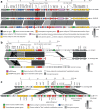Genomic characterization of the non-O1/non-O139 Vibrio cholerae strain that caused a gastroenteritis outbreak in Santiago, Chile, 2018
- PMID: 32100707
- PMCID: PMC7200058
- DOI: 10.1099/mgen.0.000340
Genomic characterization of the non-O1/non-O139 Vibrio cholerae strain that caused a gastroenteritis outbreak in Santiago, Chile, 2018
Abstract
Vibrio cholerae is a human pathogen, which is transmitted by the consumption of contaminated food or water. V. cholerae strains belonging to the serogroups O1 and O139 can cause cholera outbreaks and epidemics, a severe life-threatening diarrheal disease. In contrast, serogroups other than O1 and O139, denominated as non-O1/non-O139, have been mainly associated with sporadic cases of moderate or mild diarrhea, bacteremia and wound infections. Here we investigated the virulence determinants and phylogenetic origin of a non-O1/non-O139 V. cholerae strain that caused a gastroenteritis outbreak in Santiago, Chile, 2018. We found that this outbreak strain lacks the classical virulence genes harboured by O1 and O139 strains, including the cholera toxin (CT) and the toxin-coregulated pilus (TCP). However, this strain carries genomic islands (GIs) encoding Type III and Type VI secretion systems (T3SS/T6SS) and antibiotic resistance genes. Moreover, we found these GIs are wide distributed among several lineages of non-O1/non-O139 strains. Our results suggest that the acquisition of these GIs may enhance the virulence of non-O1/non-O139 strains that lack the CT and TCP-encoding genes. Our results highlight the pathogenic potential of these V. cholerae strains.
Keywords: gastroenteritis outbreak; multidrug resistance genomic island; non-O1/non-O139Vibrio cholerae; type III secretion system (T3SS); type VI secretion system (T6SS).
Conflict of interest statement
The authors declare that there are no conflicts of interest.
Figures



References
-
- Chatterjee S, Ghosh K, Raychoudhuri A, Chowdhury G, Bhattacharya MK, et al. Incidence, virulence factors, and clonality among clinical strains of non-O1, non-O139 Vibrio cholerae isolates from hospitalized diarrheal patients in Kolkata, India. J Clin Microbiol. 2009;47:1087–1095. doi: 10.1128/JCM.02026-08. - DOI - PMC - PubMed
Publication types
MeSH terms
LinkOut - more resources
Full Text Sources
Medical

